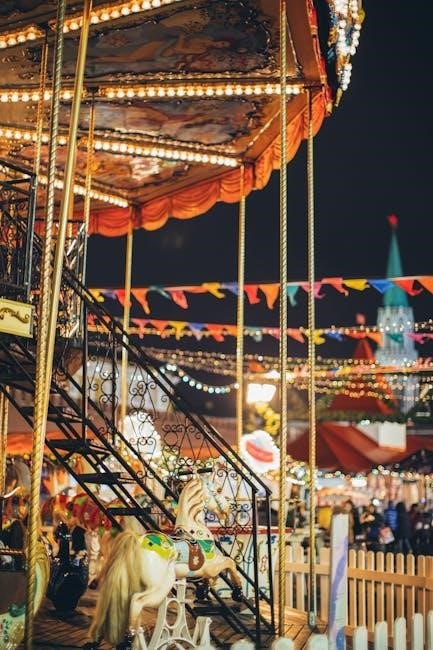“The Night Before Christmas Poem PDF” offers a timeless holiday classic, first published in 1823, featuring the iconic tale of Santa Claus and his magical Christmas Eve visit. Its rhythmic verse and vivid imagery have captivated readers for generations, making it a cornerstone of festive traditions and literature.
Overview of the Poem and Its Significance
“The Night Before Christmas” is a beloved poem that has shaped Christmas traditions and folklore. First published anonymously in 1823, it popularized modern images of Santa Claus, reindeer, and stockings. Its rhythmic verse and vivid imagery captivate readers, making it a holiday staple. The poem’s significance lies in its cultural impact, influencing literature, art, and festive celebrations worldwide. Its enduring popularity has led to numerous adaptations, translations, and educational uses, ensuring its relevance across generations and cultures.
Why the Poem Remains Popular in Modern Times
“The Night Before Christmas” endures as a holiday classic due to its timeless themes of joy, family, and magic. Its rhythmic verse and vivid imagery evoke a festive spirit, appealing to readers of all ages. The poem’s universal appeal lies in its ability to capture the essence of Christmas, making it a staple in holiday traditions. Its availability as a free PDF enhances accessibility, while its educational value ensures its use in classrooms, fostering a love for reading and holiday cheer across generations.

Publication History of the Poem
The poem was first published anonymously in the Troy Sentinel on December 23, 1823. It later appeared in Clement Clarke Moore’s anthology, gaining widespread recognition and enduring popularity.
First Publication in the Troy Sentinel
The poem, titled “Account of a Visit from St. Nicholas,” was first published anonymously in the Troy Sentinel on December 23, 1823. This initial release marked the debut of Clement Clarke Moore’s iconic work, which would later become widely attributed to him. The publication introduced the world to the now-familiar image of Santa Claus, his reindeer, and the magical Christmas Eve visit, shaping holiday traditions and popular culture forever.
Anonymous Release and Subsequent Attributions
Initially published anonymously in 1823, the poem gained popularity without a credited author. Years later, Clement Clarke Moore was acknowledged as the writer, though some scholars debate this attribution. The poem’s widespread success led to numerous reprints, often with slight modifications, further cementing its place in Christmas lore. Despite the authorship debates, Moore remains the most recognized name associated with this beloved holiday classic.

The Poem’s Structure and Style
The poem’s structure features anapestic tetrameter, creating a lively rhythm. Its vivid imagery and symbolism, like Santa’s appearance and the magical night, make it unforgettable and visually rich.

Anapestic Tetrameter and Meter
The poem is composed in anapestic tetrameter, a rhythmic meter characterized by four anapestic feet. Each foot consists of two unstressed syllables followed by one stressed syllable, creating a lively, sing-song rhythm. This meter adds to the poem’s musicality and makes it memorable and enjoyable to read aloud. The consistent rhythm enhances the narrative flow, contributing to the poem’s timeless appeal and festive spirit. The meter also complements the vivid imagery, making the story of Santa Claus and his magical night even more engaging and immersive for readers of all ages.
Imagery and Symbolism in the Text
The poem is rich in vivid imagery and symbolism, creating a magical Christmas Eve atmosphere. Santa Claus, with his round belly and twinkling eyes, symbolizes generosity and joy, while the reindeer and sleigh represent supernatural wonder. The quiet house, sugar plums, and stockings hung by the chimney evoke anticipation and innocence. The imagery of the night sky and moonlight enhances the enchantment, while the contrast between darkness and the arrival of light symbolizes hope and renewal. These elements collectively paint a timeless scene of festive magic and joy.

Cultural Impact of “The Night Before Christmas”
The poem defined Santa Claus’s appearance and behavior, popularizing elements like stockings and reindeer, while shaping Christmas traditions and folklore globally.
Shaping the Modern Image of Santa Claus
The poem profoundly influenced the modern image of Santa Claus, describing him as a jolly, gift-giving figure with a sleigh and reindeer. It popularized his physical appearance, mannerisms, and magical arrival on Christmas Eve, embedding these traits into global culture. The imagery of Santa as a cheerful, rotund man in a red suit has endured, shaping holiday traditions and folklore worldwide. This portrayal has become synonymous with Christmas, making the poem a cornerstone of Santa Claus’s cultural identity.
Influence on Christmas Traditions and Folklore
Influence on Christmas Traditions and Folklore
The poem has deeply shaped Christmas traditions, introducing elements like stockings by the chimney, reindeer-powered sleighs, and the idea of Santa Claus delivering gifts. Its vivid descriptions popularized these customs, making them central to holiday celebrations; The tradition of reading the poem on Christmas Eve has also become widespread, fostering a sense of familial bonding and festive spirit. By weaving these ideas into cultural consciousness, the poem has left an indelible mark on global Christmas folklore, inspiring countless adaptations and traditions that endure to this day.

The Night Before Christmas Poem PDF Availability
The poem is widely available as a free downloadable PDF, perfect for sharing, printing, or classroom use. Many educational websites offer it, ensuring easy access for all.
Free Printable Versions for Educational Use
Free printable versions of “The Night Before Christmas” are widely available, making it easy to incorporate into classroom activities. Teachers can download the PDF to print copies for students, fostering engaging literacy exercises. These versions are ideal for reading fluency practice, class discussions, and holiday-themed lessons. The poem’s rhythmic structure and vivid imagery make it a valuable tool for teaching literature and language arts. Many educational websites offer these printables, ensuring accessibility for schools and homeschooling environments. This resource enhances festive curricula while promoting a love for classic poetry.
Downloading and Sharing the PDF
Downloading and sharing the PDF of “The Night Before Christmas” is straightforward, with many websites offering free access to the poem. Users can easily save the file to their devices or share it via email, social media, or cloud platforms. The PDF format ensures high-quality text and illustrations, making it ideal for personal reading or distribution in educational settings. Sharing the poem digitally allows it to reach a wider audience, spreading its timeless magic during the holiday season and beyond.

Educational Uses of the Poem
The poem is widely used in educational settings for reading activities and discussions, enhancing literacy and fostering holiday spirit in classrooms.
Classroom Activities and Discussions
The poem is a great addition to Christmas-themed lessons, offering opportunities for reading aloud, class discussions, and creative activities. Teachers can use the text to explore imagery, rhythm, and symbolism, while also discussing its historical and cultural significance. Students can engage with the poem by illustrating scenes, writing sequels, or analyzing the metaphor of Santa Claus. Additionally, the poem’s themes of joy and giving inspire reflective discussions about holiday traditions and values, making it a valuable tool for fostering both literacy and emotional intelligence in students.
Using the Poem for Reading Fluency Tests
The poem’s rhythmic and repetitive structure makes it ideal for assessing reading fluency. Educators can use it to measure students’ reading rates and accuracy, as its familiar content reduces anxiety. The text’s anapestic tetrameter and rhyming scheme help students practice prosody and expression. By timing readings or using digital tools, teachers can track progress and provide targeted feedback, ensuring students develop smooth and natural reading skills in a engaging and festive context.

Controversies and Misconceptions
Despite its popularity, “The Night Before Christmas” faces debates over its authorship and cultural appropriation, prompting discussions on its historical accuracy and representation;
Debates Over Authorship and Cultural Appropriation
Controversies surrounding the poem include disputes over its authorship, with some attributing it to Henry Livingston rather than Clement Clarke Moore. Additionally, critics argue that the poem perpetuates cultural appropriation through its portrayal of Santa Claus and reindeer, which draw from diverse traditions. These debates highlight the complexities of the poem’s origins and its evolving cultural significance, sparking discussions about representation and historical accuracy.

Legacy and Adaptations
The poem’s timeless appeal has led to numerous adaptations, including illustrations by renowned artists and modern interpretations. Its themes and imagery continue to inspire global translations and cultural reinterpretations.
Modern Interpretations and Illustrations
The poem has inspired countless modern interpretations, from vibrant illustrations by artists like Helmuth F. Thoms to digital adaptations featuring animated visuals. Its timeless themes are now shared through downloadable PDFs, making it accessible to new generations. Illustrators continue to reimagine Santa Claus and the magical night, blending traditional and contemporary styles. Digital media has further enhanced its reach, offering interactive readings and translations in multiple languages, ensuring its global appeal endures.
Translations and Global Reach
The poem’s global influence is evident through its translations into over 100 languages, facilitated by tools like Google Translate. Its universal themes resonate across cultures, with PDF versions available worldwide. From Spanish to Mandarin, it’s adapted to preserve its holiday charm, making it a shared tradition globally. This linguistic diversity ensures its message of joy and giving is accessible to all, fostering unity across borders and generations. Its reach continues to expand, enriching holiday celebrations everywhere.
“The Night Before Christmas” remains a beloved holiday classic, its PDF versions widely shared for educational and festive purposes. Its enduring popularity stems from shaping Santa Claus’s image and influencing traditions. Despite authorship debates, its cultural impact is undeniable. Translations and adaptations ensure its global reach, making it a timeless tale. Its legacy continues to inspire, offering joy and reflection during Christmas, solidifying its place in literature and tradition for future generations to cherish.
